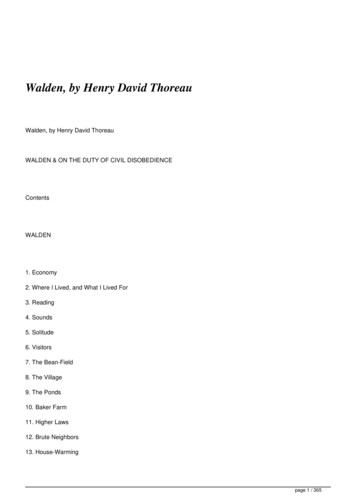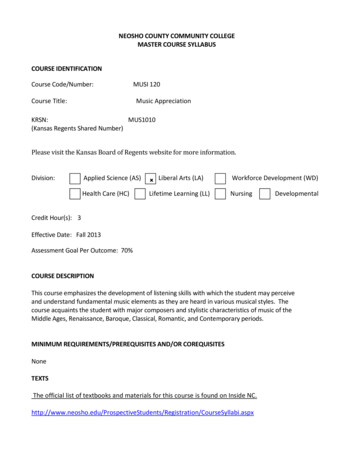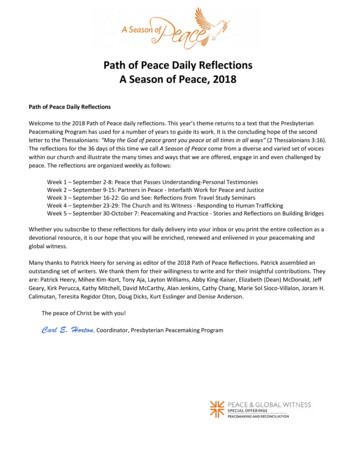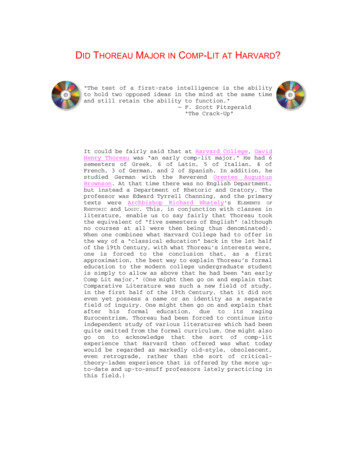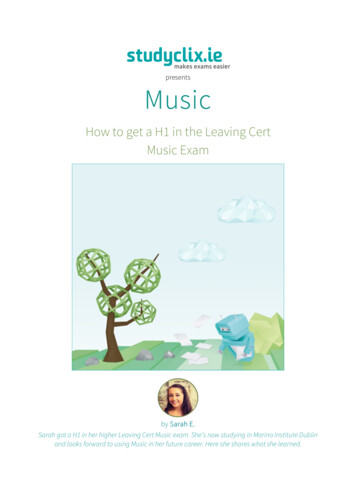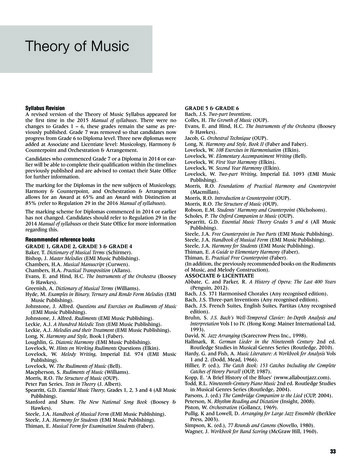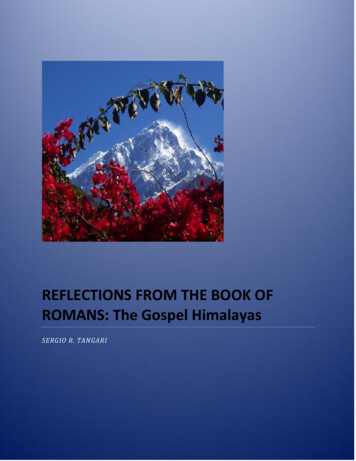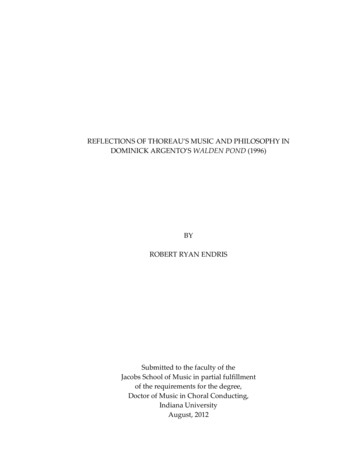
Transcription
REFLECTIONS OF THOREAU’S MUSIC AND PHILOSOPHY INDOMINICK ARGENTO’S WALDEN POND (1996)BYROBERT RYAN ENDRISSubmitted to the faculty of theJacobs School of Music in partial fulfillmentof the requirements for the degree,Doctor of Music in Choral Conducting,Indiana UniversityAugust, 2012
Accepted by the faculty of the Jacobs School of Music,Indiana University, in partial fulfillment of the requirementsfor the degree Doctor of Music in Choral Conducting.Aaron Travers, Research DirectorCarmen-Helena Téllez, ChairpersonWilliam Jon GrayBlair Johnstonii
Copyright 2012Robert Ryan Endrisiii
AcknowledgmentsThere are many people without whose help and support this document andthe completion of this degree would not be possible. First and foremost, I mustacknowledge Dr. Robert S. Hatten, former professor of music theory at IndianaUniversity and current professor of music theory at University of Texas. Dr.Hatten’s seminar “Music and the Poetic Text” sparked my interest in therelationship between poetic texts and vocal music and provided the impetus forthis document. He inspired me to experience, analyze, and understand vocalmusic in a completely new way.I must also thank the members of my document committee. I am deeplyindebted to my research director, Dr. Aaron Travers, and my chairperson, Dr.Carmen-Helena Téllez, for their efforts and willingness to lead me through thisprocess of research, analysis, and writing. I also thank Dr. Blair Johnston and Dr.William Jon Gray for their contributions through insightful comments,observations, and suggestions.Next, I would like to express my gratitude for the support andencouragement offered by my mentors and friends. A special heartfelt thanksgoes out to Dr. Michael Schwartzkopf and Dr. Jan Harrington for their unendingsupport and advice, both academically and personally, from the beginning of myiv
academic career. Thank you, Laura Cameron, Ben and Andrea Dalton, GregGeehern, Benjamin Geier, Juan Camilo Hernández, Kevin Neel, Evelyn Nelson,Bernadette Wagner, Juan Carlos Zamudio, and many others, for being the bestfriends and colleagues one could hope for. I especially thank my good friendRachel Rosolina for volunteering her amazing copyediting skills to ensure thisdocument is error-free. Finally, I must thank my family, especially my parents,for encouraging me to follow my dreams and never insisting that I pursue a“practical” career.v
PrefaceThis book aims to explore and interpret the relationship of the music withinThoreau’s poetic text Walden (1854) with the music composed by Minnesotabased composer Dominick Argento in Walden Pond, Nocturnes and Barcarolles forMixed Chorus, Three Violoncellos and Harp (1996). In addition to contributing to thescholarship and research related to Argento—there is little research on Argento’schoral music, and none pertaining to this specific piece—this paper will serve asa model of one type of analysis for the music of Argento, who is knownprimarily for his lyric operas and choral music.The objectives of this document are to analyze thoroughly the poetic soundsand devices of Thoreau’s otherwise prose text, to analyze the music elements andstructure of Argento’s musical setting, and to demonstrate the interrelationshipof Thoreau’s poetic text and Argento’s setting of it in each of the five movementsof the piece. By recreating the Stimmung of the poetic text, Argento captures theaesthetic, religious, and philosophical ideas held by Thoreau.In the introduction, I provide detailed background information on Thoreau,his book Walden, and the American Transcendentalist movement that providedmuch of the philosophical, spiritual, and natural inspiration for the text.Additionally, I have included biographical information about Argento, as wellvi
his and others’ insights into his compositions, specifically his choral music andWalden Pond.I have dedicated a chapter of in-depth analysis to each of the five movementsof the work. Each chapter will follow the same organization of methodology. Ineach chapter, I first analyze thoroughly the poetic text of Thoreau, paying specialattention to the “music” that is created through sentence sounds, rhythm, tempo,etc., using Robert Pinsky’s The Sounds of Poetry (1998) as a principal guide.1 I thenlook closely at how Argento honors Thoreau’s poetic music in his setting of thetext (rhythmic and melodic correlations with the rhythmic and intonationalimplications of the text). Finally I examine how Argento captures the overallimagery and atmosphere of the text (Stimmung) globally through texture,instrumentation, and topics, and locally by identifying specific word-paintingexamples and leitmotifs.In this book, I define leitmotifs as recurrent referential sonorities and motivesthat carry extramusical meaning. Like the harmonic leitmotifs of Wagner andStrauss, many of the leitmotifs in Walden Pond are chords. Likewise, many of theleitmotifs I have identified occur in the accompanying instruments. I have usedLeonard B. Meyer’s books Emotion and Meaning in Music (1956) and ExplainingMusic (1973) to guide me in identifying motivic structures. I also discussRobert Pinsky is Poet Laureate of the United States and teaches in the graduate writing programat Boston University.1vii
Argento’s implementation of musical topics, doing so in Robert Hatten’s use ofthe word.2It is assumed that the reader has access to a score to refer to while readingthis document. All of the quotations of Thoreau’s text in chapters 1–5 are set inthe musical composition, and the entire text of Walden Pond can be found inappendix A. I have also provided a catalog of leitmotifs for easy reference inappendix B. It is my hope that this book will serve as a model for this specifictype of analysis and a valuable resource for those who perform Walden Pond.2Robert S. Hatten, Musical Meaning in Beethoven: Markedness, Correlation, and Interpretation(Bloomington, IN: Indiana University Press, 1994).viii
Table of ion1Chapter 1. “The Pond”17Chapter 2. “Angling”31Chapter 3. “Observing”44Chapter 4. “Extolling”59Chapter 5. “Walden Revisited”73Conclusion83Appendix A89Appendix B92Bibliography93ix
Figures1. Reflection chord232. Reduction of Acceptance sonority253. Use of modal mixture264. Disjunct melody as text-painting285. Flute motive386. Permanence chord397. Hymn; Abide With Me438. BTS motive; Walden Pond, mvmt. 3, mm. 28–31519. BTS motive; Walden Pond, mvmt. 3, mm. 40–425210. Altered Acceptance sonority5311. Reworked Reflection chord5412. Canonic Entrances5513. Anabasis for the word float; Walden Pond, mvmt. 3, mm. 71–725614. Anabasis for the word float; Walden Pond, mvmt. 1, mm. 38–395615. Pond’s surface5716. Love chord and resolution; Walden Pond, mvmt. 4, mm. 3–46717. Love chord and resolution; I Hate and I Love, mvmt. 2, mm. 17–226718. Eternal Divinity Chord6819. Reflection chord69x
20. Combined use of Reflection chord and Eternal Divinity Chord7121. Modal mixture7922. Quote from movement 18023. Reflection chord8024. Pond’s Surface and Reflection Chord82xi
AppendicesA. Text of Walden Pond88B. Catalog of leitmotifs90xii
Glossaryadnomination. Emphasis of a word root through its use in various parts ofspeech.alliteration. The repetition of consonants.allophone. A written speech sound that includes all of its possiblepronunciations.anabasis. A rhetorical gesture in music depicting physical upward motion orlocational height through melodic contour or tessitura.assonance. The repetition of vowels.catabasis. A rhetorical gesture in music depicting physical downward motion orlocational height through melodic contour or tessituradactylic. Description of the meter of a poetic text as having one strong syllablefollowed by two weak syllables.hyperbole. Exaggeration for the purpose of dramatic effect.onomatopoeia. Poetic device where a word sounds like what it means orrepresents.personification. Poetic device where personal or human qualities are ascribed toa non-human or inanimate object.phoneme. A basic, distinctive speech sound.trochaic. Describes the meter of a poetic text as having one strong syllablefollowed by a weak syllable.xiii
IntroductionHenry David Thoreau and WaldenOn July 12, 1817, Henry David Thoreau was born in Concord, Massachusetts,to John Thoreau, a skilled pencil maker, and Cynthia Dunbar, who ran aboardinghouse.3 He graduated in 1837 from Harvard University but immediatelyreturned to Concord and began working there. He first worked as a teacher andthen as a day laborer; most importantly, he worked for Ralph Waldo Emersonand lived in his house.4 In 1845 at the age of twenty-seven, Thoreau borrowed anaxe from Emerson and built a log cabin on some land—Walden—which wasowned by Emerson.5Thoreau went to Walden in March of that year to see if he could achieve asuitable balance between labor and leisure by living life as simply as possible.6Following in the footsteps of European Romantics, Thoreau moved to Walden toobserve and write about nature; however, he also sought to teach a lesson tosociety about the value of work.7 Thoreau did write specifically about his ownJames. Thorpe, Thoreau's Walden (Pasadena: The Castle Press, 1977), 3.Ibid., 5.5 Ibid., 9.6 Paul F. Boller, American Transcendentalism, 1830-1860: An Intellectual Inquiry (New York: Putnam,1974), 206.7 Robert Sullivan, The Thoreau You Don't Know (New York: Harper Collins, 2009), 123.341
2motivations for inhabiting Walden: “I went to the woods because I wished to livedeliberately, to front only the essential facts of life, and to see if I could not learnwhat it had to teach, and not, when I came to die, discover I had not lived.”8Thoreau spent precisely two years, two months, and two days at Walden,although he did make regular trips into town to visit friends.9 While he wasthere, Thoreau wrote most of A Week and Walden, but he left in 1847 because he“had other lives to live and could spare no more time for that particular life.”10Although he had written the majority of Walden while living there, Thoreauspent nearly six years continuing to write and edit the book, finally publishing itin Boston in 1854.11 Thoreau died eight years later in May of 1862 fromtuberculosis, which he had contracted some twenty-six years earlier in the springof 1836.American TranscendentalismOne cannot entirely understand Walden without reading it within the contextof the contemporary American Transcendentalism movement; as GeorgeHochfield writes, “Like those of all movements in intellectual history, theThorpe, 10.Ibid.10 Boller, 207.11 Thorpe, 17.89
3outlines of American Transcendentalism are indistinct.”12 Paul Boller describesAmerican Transcendentalism as a religious, philosophical, and literarymovement that promoted free thinking in religion and both Romanticism andindividualism in literature.13 This ideology began as a movement againsttraditional, historical Christianity out of the Unitarian Church in New England inthe 1830s.14 Clearly delineating this ideology, Ralph Waldo Emerson suggestedthat “if a person wished to know what Transcendentalism was about, he shouldempty his mind of everything coming from tradition and the rest would beTranscendentalism.”15In the most basic of definitions, American Transcendentalism sought toreconcile science and religion, aimed to bring to the forefront the role of theintellectual in the world, and desired to emphasize both freedom andindividuality.16 Transcendentalists were “relentlessly self-critical, endlessly eagerto expand their knowledge, experience, and understanding of life.”17 At the sametime, the Transcendentalist aesthetic of art and literature came from organicgrowth. Artists’ and writers’ inspiration came from within one’s self, and thatGeorge Hochfield, "An Introduction to Transcendentalism," in American Transcendentalism, ed.Brian M. Barbour(Notre Dame, IN: Notre Dame Press, 1973), 35.13 Boller, xix–xx.14 Ibid., xviii–xix.15 Ibid., 34.16 Hochfield, 51.17 Boller, xv.12
4inspiration manifested itself in a physical form naturally and freely by followinghis or her own creative spirit.18The American Transcendentalists were quite concerned with the “organicmetaphor,” which is interpreting reality in terms of analogies to the naturalworld (that is, plant life and animal life).19 The ideas of many writers, such asEmerson and Thoreau, include “the divinity of nature, the glory of humanaspiration and freedom, the power of intuition as opposed to reason, [and] thecreative energy of the poetic imagination.”20 Boller states, “Transcendentalismplaced great emphasis on the unity as well as the variety of nature,” and notesthat Emerson had called it “all for each and each for all,” meaning thateverything is part of the perfection of the whole.21More specifically, the American Transcendentalists envisioned a divinepower or energy that creates all that is good and beautiful in the universe,22 butthey were often scorned for seeking God in nature, or more importantly, forsimply seeking God beyond the church’s walls.23 For the Transcendentalist,nature keeps understanding and reason in balance and, according to Emerson,serves as a source of resources, an unblemished world of beauty, and inspirationIbid., 95.Hochfield, 41.20 Ibid., 36.21 Boller, 77–78.22 Ibid., 67.23 Sullivan, 42.1819
5for writing.24 Thoreau wrote that nature is as much a part of the person as theperson is a part of nature, and the Transcendentalists realized that althoughindividual, each person is comprised of a series of relations.25With this in mind, the American Transcendentalists focused on creativity,sociality, and most importantly, individuality—Emerson said, “Nature neverrhymes her children, nor makes two men alike.”26 They believed that theindividual—not society—was the source of all inspiration, creativity, andoriginality, and although society may exert a certain amount of influence, itcannot create as the individual can.27 Emerson insisted on “an individual’s selfreliance . . . a reliance on the activation of one’s own soul, an interior awarenessof the world’s divinity and the divinity inside one—i.e. you.”28Thoreau, Transcendentalism, and WaldenOf the American Transcendentalist philosophies, Thoreau concerned himselfprimarily with two in writing Walden: nature and the individual. He did notleave behind any manuals on theories, philosophies, or aesthetics,29 but his viewsBoller, 50.Ibid., 195.26 Ibid., 190.27 Ibid., 191.28 Sullivan, 45.29 Verena Kerting, Henry David Thoreau's Aesthetics (New York: Peter Lang, 2006), 5.2425
6on such matters were not entirely unknown. Of all the AmericanTranscendentalists, Thoreau most ardently rejected establishment, religion inparticular, although he did not consider himself an atheist. He once said that hepreferred the sound of cow bells to the sound of church bells.30 He did notbelieve in personal immortality and wrote that there was “no heaven but thatwhich lies about me.”31 For Thoreau, nature was his religion. He did not alignhimself with traditional Romanticists that viewed nature as a supernatural orimaginative realm; rather, he believed that “truth could only be derived from anempirical contemplation of the actual, phenomenal world.”32 Richard Schneidersums up this philosophy quite well: “For Thoreau, the purpose of life’s journey isto explore this [spiritual] potential, and nature provides the world, the morallandscape, in which to explore it.”33Personally, Thoreau wanted to bridge the gap between body and mind, thephysical world and the spiritual realm.34 While Emerson viewed nature as a“physical means to a spiritual end,” Thoreau found spirituality through nature.35In fact, Thoreau felt such a deep connection with nature that he achieved anBoller, 29.Ibid., 30.32 Kerting, 1.33 Richard J. Schneider, "Walden," in The Cambridge Companion to Thoreau, ed. Joel Myerson (NewYork: Cambridge University Press, 1995), 100.34 Kerting, 61.35 Schneider, 100.3031
7ecstatic state that overwhelmed his consciousness.36 He became unified withnature, and he had become acutely aware—through all of his senses—ofeverything surrounding him.37 But for Thoreau, senses alone did not grasp orcapture full knowledge and understanding of an experience; they merelyintroduced the phenomenon to the intellect, and together they would form anunderstanding.38 It was through nature that Thoreau sought to understand notonly the world around him, but also to know more thoroughly his own being. Inhis essay “Resolution at Walden” Sherman Paul writes, “In Walden Pond,[Thoreau] saw the image of his purified self—that pristine, eternal self he hopedto possess.”39Through Walden, Thoreau aimed to give an account of nature based on hisexperiences, since fixed theory does not suffice with nature constantlychanging.40 He marketed this book as a travel book (a very popular genre at thetime) with himself as the tour guide, but Walden is not simply an account of histravels; rather, the writing serves to inspire people to explore and be seekers oftruth.41 A common myth about Walden is that it is a text about a hermit, a manwho isolates himself from society for two years and spends that time meditatingBoller, 195.Kerting, 97.38 Ibid., 70.39 Sherman Paul, "Resolution at Walden," in Critical Essays on Henry David Thoreau's Walden, ed.Joel Myerson (Boston: G.K. Hall & Co., 1988), 61.40 Kerting, 61.41 Schneider, 93.3637
8in nature. On the contrary, Thoreau is more interested in change than stasis,exploration than observation.42 In fact, Thoreau adopted a view of life withmankind as transient and nature as permanent.43For Thoreau, nature did not need to be idealized in art; to do so would onlyreflect a shadow of its true beauty and only a mere snapshot—not a video—ofthe experience.44 Kerting expounds upon this idea: “Instead of producing poetrythat conveyed merely the shell of an experience and that was mainly determinedby his self, Thoreau wished to capture and convey the vividness andcharacteristics of the objects themselves.”45 Nature was already perfect, and hedid not believe it needed a poet to make it perfect. Instead, he thought thatpeople needed to learn how to open themselves up to be able to perceivenature.46 From a very basic perspective (one that Thoreau himself would likelyadopt), Walden is a book about purity and innocence as represented by natureand about the need for individuality as human beings.47Thoreau draws his inspiration for Walden from nature, which then serves astropes and metaphors that represent his observations and concepts.48 ThroughIbid., 92.Thorpe, 14.44 Kerting, 96.45 Ibid., 109.46 Ibid., 2.47 Thorpe, 22.48 Elizabeth Hall Witherell, "Thoreau as Poet," in The Cambridge Companion to Thoreau, ed. JoelMyerson (New York: Cambridge University Press, 1995), 57.4243
9his choice of language, he strategically draws the reader toward the self, society,nature, and God—all at the same time.49 Thoreau draws upon the images andscenes of the natural world in and around Concord in his writings and poems,and “applies the high standards of his idealism to aspects of the humancondition—love, friendship, memory, the transitory nature of life.”50 In his essayabout the deeper truths of Walden, Joseph Boone writes, “One of Thoreau’soverriding purposes in writing Walden involves his effort to educate his audienceof the difference between the conventional life that merely skims the surface ofexistence and the fully-experienced life that fathoms its depths.”51To emphasize on a global level the process of death and rebirth in thereader’s own journey, Thoreau represents Walden chronologically through thecycle of seasons, condensing his roughly two-year stay into one year.52 On a locallevel, the morning and the light of the breaking dawn represent rebirth andhuman potential for abundant life.53 Although Thoreau did not share many of theRomantic views of nature as supernatural or magical, “in style as well asJoseph J. Moldenhauer, "The Extra-Vagant Manuever: Paradox in Walden," in Critical Essays onHenry David Thoreau's Walden, ed. Joel Myerson (Boston: G.K. Hall & Co., 1988), 98.50 Witherell, 57.51 Joseph Allen. Boone, "Delving and Diving for Truth: Breaking through to Bottom in Thoreau'sWalden," in Critical Essays on Henry David Thoreau's Walden, ed. Joel Myerson (Boston: G.K. Hall& Co., 1988), 164.52 Schneider, 97.53 Ibid., 103.49
10structure, in language as well as idea, then, Thoreau recapitulates the archetypalRomantic theme of rebirth.”54Walden displays a constant interchange between prose and poetry; even inThoreau’s poems, there is a constant interchange between the two.55 He was alsoquite passionate about etymology and how words having multiple meaningscould lead to deeper truths.56 Thoreau’s use of puns and the fact that words havemultiple meanings, however, sometimes undermine his ability to find certaintyin language.57 In Walden, Thoreau “leavened his message about the economics ofeveryday life with puns, wordplays, and outright one-liners,” as humor wasimportant to him.58 In fact, the book is filled with puns, such as the unluckyfisherman, who after a long time realized “he belonged to an ancient sect ofCoenobites (‘see no bites’).”59 Besides the number of puns and subtle jokes,Thoreau’s writing exhibits clarity of form, fluidity, and a music-like quality.Broderick states in his essay, “Many of Thoreau’s paragraphs . . . often beginwith deceptively simple, largely monosyllabic utterances which are succeeded bypoetic, allusive, metaphorical enrichment before the return.”60John C. Broderick, "The Movement of Thoreau's Prose," in Critical Essays on Henry DavidThoreau's Walden, ed. Joel Myerson (Boston: G.K. Hall & Co., 1988), 84.55 Witherell, 62.56 Sullivan, 170.57 Schneider, 96.58 Sullivan, 167.59 Schneider, 95.60 Broderick, 80.54
11Dominick ArgentoDominick Argento was born to Sicilian immigrants on October 27, 1927 inYork, Pennsylvania. He began his musical studies much later in life than mostprodigious musicians at the age of fifteen, when he began formally studyingpiano and informally studying harmony and orchestration from books heborrowed from the local library.61 During World War II, Argento entered the U.S.Army through the draft and served as a cryptographer in Northern Africa.62Upon his return to the United States, he enrolled at the Peabody Conservatory inBaltimore, Maryland, to begin his collegiate studies in composition, earning hisBachelors of Music and Masters of Music in Composition in 1951 and 1954,respectively. In 1957 he graduated from the Eastman School of Music inRochester, New York, with a PhD in Composition.63Soon after completing his doctorate at the Eastman School of Music, heapplied for and accepted a position on the faculty at the University of Minnesota,where he would spend his entire academic career.64 While there, Argento enjoyedgreat success in both the academic and professional arenas. In 1963, heThe McKnight Foundation, Dominick Argento (Minneapolis, Minnesota: The McKnightFoundation, 1998), 36.62 Virginia Saya, "Argento, Dominick," Grove Music Online. Oxford Music /article/grove/music/01222 (accessed December 27,2011).63 The McKnight Foundation, 36.64 Ibid.61
12cofounded the Center Opera Company, now known as the Minnesota Opera,and composed its inaugural opera Masque of Angels in that same year.Argento’s work soon gained national recognition; in 1975 he won the PulitzerPrize for From the Diary of Virginia Woolf, 65 a thirty-five-minute collection of eightsongs for medium voice and piano based on excerpts from Virginia Woolf’sdiaries.66 Sixteen years later, he received nomination for a Grammy Award for a1991 recording of his Te Deum,67 an oratorio for chorus and symphonic orchestraset to the Latin Te Deum text and anonymous Middle English lyrics.68 In 1997,Argento retired from the University of Minnesota on December 31, and in thatsame year was appointed Composer Laureate of the Minnesota Orchestra.69Argento and His MusicFor Argento, the process of composing a piece, once finished, is like a distantmemory. He states that it is practically impossible to describe and recount theevents that transpire during his compositional processes. Most of the time, thepiece he begins to compose (or the piece he thinks he is composing) and theIbid.Dominick Argento, Catalogue Raisonné as Memoir (Minneapolis: University of Minnesota Press,2004), 82.67 The McKnight Foundation, 37.68 Argento, 133.69 The McKnight Foundation, 37.6566
13finished composition stand in stark contrast to one another.70 A long time afterfinishing a composition, the piece becomes alien to Argento. He usually cannotremember the significance of any particular chord or note.71Argento rarely draws his inspiration or compositional techniques from othercomposers, although he is particularly fond of Romantic composers, specificallyMahler, Tchaikovsky, Verdi, and Puccini.72 According to Argento, the process ofmaking musical decisions (e.g. the sequence of pitches, dynamics, rhythmicdurations, and placement of dissonance) is essentially arbitrary, as he composeshis music based on his own instinct.73 While some elements of Argento’s musicmight be intuitive, his use of established forms, leitmotifs, and recurring musicalmaterial inherently suggests conscious musical decision-making.In the earliest stages of his career, his instincts drove him away from vocalmusic. In fact, he had a strong aversion to vocal music through his third year atthe Peabody Conservatory. After marrying his wife Carolyn Bailey (whom hedescribes as “a terrific soprano”), he began to experiment with composing solovocal repertoire, but much time would pass before he began to appreciate groupArgento, xiv.Ibid., xv.72 Ibid., 15.73 Ibid., xvi.7071
14singing. He admits that living in Minnesota, a state with a rich tradition andculture of choral music, helped him greatly.74Stuart Pope of Boosey and Hawkes, one of Argento’s publishers, once toldhim that all of his choral music is, at best, challenging and quite oftenexceedingly difficult.75 Argento attributes this to his free use of tonality and hisoccasional, albeit brief, employment of atonality. He counters, however, that healways considers the singer and the vocal instrument in general when composingchoral music by designing vocal lines and melodic contours that are notawkward to sing, placing reference points within the piece for finding pitches,and avoiding unnecessary demands in regards to vocal stamina and tessitura.76Most important and relevant to this book is Dominick Argento’s approach tosetting a text to music. He describes setting a piece of vocal music in the originalmeter of a given text as “the worst thing you can do.”77 One of the primaryreasons that he has chosen to set mostly prose texts (such diaries, letters,pamphlets, etc.) and not very many poems is that he retains absolute control overthe meter and the rhythm of the text; that is, he, not the meter of the source text,decides which words are important and should be stressed,.78Ibid., 112.Ibid., 58.76 Ibid., 59.77 Ibid., 9.78 Ibid.7475
15Walden Pond (1996)Argento’s meticulous attention to text provided the impetus for his choralwork Walden Pond, a cycle for chorus, three celli, and harp commissioned by theDale Warland Singers (Dale Warland, conductor) and premiered on October 26,1996, at the University of Minnesota. With great care and extensive freedom, heselected excerpts (quoted verbatim) from Thoreau’s Walden to create the preciseimagery and ambience he sought to capture in the piece, but this is not the firsttime he has done so. According to Deborah Ellefson in her dissertation “TheChoral Music of Dominick Argento”, Argento “prefers to design his own textualstructure; of the multi-movement works, Peter Quince at the Clavier is the only onethat sets a single text in its entirety. All of the others employ excerpts frommultiple poems or texts, selected and rearranged by Argento.”79In combination with the excerpted texts selected by Argento, his choice ofinstrumentation also plays a crucial a role in creating the Stimmung of the work.The German word for “mood,” the term Stimmung refers to the generalatmosphere, sentiment, or imagery of a musical passage. Virginia Saya writesthat the “three cellos and harp support and illustrate the water images in theDeborah Ellefson, “The Choral Works of Dominick Argento” (Dissertation, Arizona StateUniversity, 1990), 43.79
16settings of texts compiled by Argento from Thoreau’s Walden.”80 Argento goes astep further in specifically noting that the harp mimics the sound of ripplingwater and the three violoncelli—Argento borrowed the use of multiple solo cellifrom Rossini’s William Tell overture, in which Rossini employs them to depict aserene woodland scene—“add a sense of warmth, darkness, and depth.”81The decision for Argento to set a text about the pond at Walden surely musthave been an obvious one. In his memoir, he writes that he has always beenfascinated by bodies of waters—lakes, rivers, seas—and that many of his vocaland choral works are set on or near a body of water, even if he does not mentionwater specifically in the piece’s title.82 Argento writes specifically about hisfascination with water with regard to Walden Pond: “Walden Pond would be theone work most unabashedly related to this preoccupation [with bodies of water],using it not merely as a circumstance or colorful backdrop, but focusing directlyon the body of water itself.”83Saya.Argento, 171.82 Ibid., 170.83 Ibid., 171.8081
Chapter 1“The Pond”The Music in Thoreau’s Poetic TextWhile not pure poetry in the strict sense, Thoreau’s writing is rife with poeticdevices, textual “music,” and rhetorical gesture. The opening sentence of themovement (“Nothing so fair, so pure lies on the surface”) exhibits a litany ofsibilant sounds through all
the musical composition, and the entire text of Walden Pond can be found in appendix A. I have also provided a catalog of leitmotifs for easy reference in appendix B. It is my hope that this book will serve as a model for this specific type of analysis and a valuable resource for those who perform Walden Pond.
